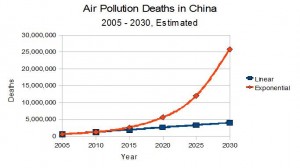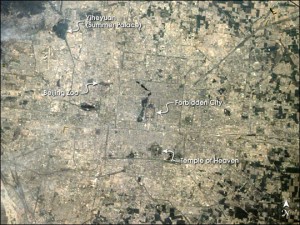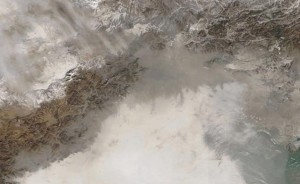China Air Pollution 中国空气污染
The Bitter Years Return 的苦涩年返回
During the “Bitter Years” from 1958 to 1962, an estimated 15 to 43 million people died of starvation in China (wikipedia). Mao, who ate well during that time, did not want help from the west. Fast forward to today. It has been reported that due to air pollution, an estimated 650,000 people died in China in 2006, and another estimated 1.2 million died in 2010. Knowing these 2 data points of this dynamic system, we can plot a curve. The blue line assumes a linear curve, the red line, the exponential uptick of a sigmoid curve. Assuming reinforcing feedback, the red curve is more likely.
The three most important questions are
- “How serious is the air pollution?”
- “What will it take before the Chinese government acts?”
- “What will be the delay between action and results?
The short answer to Question 1 is “Very.” If this is as serious as I think it is, the challenge for the government of the People’s Republic of China as for other governments, will be to stop polluting and clean up the pollution it has allowed to be dispersed into the bio-humano-sphere. However, this conflicts with the apparent goal of the Chinese government to be the world’s biggest producer of stuff without regard to pollution.
I can not begin to answer Question 2. However, I would hazard a guess that the Chinese authorities must first realize that they have a problem. Given the size of the population, the absolute power wielded by the Central Committee, the appearance of a callous disregard for the citizens, I would suspect that it could take another 15 to 25 years for the Central Committee to act. It will, of course, be influenced by other factors, including the standard of living, the birth rate, morbidity and mortality associated with water pollution, toxins in the food supply, a lack of construction standards.
The answer to Question 3 requires understanding that it is easier to stop pollution at a point source, such as a factory, power plant, or car, than to pull dispersed particulates out of the atmosphere.
To return to Question 1, the image below, shows Beijing before heavy industrialization and pollution.
This shows Beijing in the winter of 2013 – during heavy industrialization and pollution.
From 650,000 in 2006 the number of deaths from air pollution in China grew to 1.2 million in 2010. If this follows a linear function then 137,500 more people die each year in China due to air pollution and will be 1.9 million per year and a total of 13 million people by 2015, 2.6 million per year and a total of 24.2 million by 2020; 3.26 million and a total of 4.6 million per year and a cumulative total of 79,212,500 by 2035
If it follows an exponential function then the number has increased by 16.565% per year from 2006 to 2010 and will be 2.6 million in 2015 for a total of 14 million people; 5.6 million per year in 2020 for a total of 35 million people; and 55 million people per year in 2035 for a total of 386 million people.
Table 1, below, shows the projections for annual and cumulative deaths out to 2035.
| Deaths in China from Air Pollution, Estimates | ||||
| Year | Deaths | Cumulative | Deaths | Cumulative |
| Linear | Exp | |||
| Increase | 137,500 | 16.565% | ||
| 2005 | 512,500 | 542,328 | ||
| 2006 | 650,000 | 650,000 | ||
| 2010 | 1,200,000 | 4,625,000 | 1,200,000 | 4,520,347 |
| 2015 | 1,887,500 | 12,687,500 | 2,582,420 | 14,248,100 |
| 2020 | 2,575,000 | 24,187,500 | 5,557,349 | 35,182,158 |
| 2025 | 3,262,500 | 39,125,000 | 11,959,377 | 80,232,101 |
| 2030 | 3,950,000 | 57,500,000 | 25,736,494 | 177,179,261 |
| 2035 | 4,637,500 | 79,312,500 | 55,384,754 | 385,808,863 |
| Table 1 | ||||
The 1.2 Million people who died in China from air pollution in 2010 constituted approximately 0.09% of the population, less than 0.1%.
Unlike the famine of the “Bitter Years,” this problem can not be solved by a plan to distribute food or even asking for help from the west. The air is unbreatheable. Faced with killer pea soup smogs, the people of London banned the burning of coal inside the city. Similarly, this can only be solved by developing and deploying clean industrial processes.
As noted above, this analysis does not take into account the number of people who will die from HIV/AIDS, water pollution, infectious disease, problems in the food supply, other factors or reinforcing feedback effects on mortality between those problems and air pollution.
–
The posts in this series:
L. Furman, Popular Logistics, 2/4/13, Forget the Great Wall, Meet the Great Haze.
L. Furman, Popular Logistics, 7/1/13. China Air Pollution: The Bitter Years Return?
–
A candidate for General Assembly (Site / Join / Contribute) to represent NJ Legislative District 12, I hold a Bachelor’s in Biology and an MBA in “Managing for Sustainability” from Marlboro College. I can be reached at ‘L Furman 97” @ G Mail. I am available for consulting to governments of People’s Republic of China, the United States, as well as the United Nations and NGOs. My requirements are modest.


